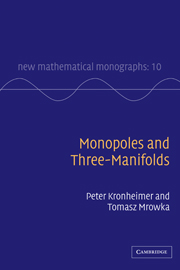Book contents
- Frontmatter
- Contents
- Preface
- I Outlines
- II The Seiberg–Witten equations and compactness
- III Hilbert manifolds and perturbations
- IV Moduli spaces and transversality
- V Compactness and gluing
- VI Floer homology
- VII Cobordisms and invariance
- VIII Non-exact perturbations
- IX Calculations
- X Further developments
- References
- Glossary of notation
- Index
III - Hilbert manifolds and perturbations
Published online by Cambridge University Press: 19 September 2009
- Frontmatter
- Contents
- Preface
- I Outlines
- II The Seiberg–Witten equations and compactness
- III Hilbert manifolds and perturbations
- IV Moduli spaces and transversality
- V Compactness and gluing
- VI Floer homology
- VII Cobordisms and invariance
- VIII Non-exact perturbations
- IX Calculations
- X Further developments
- References
- Glossary of notation
- Index
Summary
In finite-dimensional Morse theory, the reconstruction of the ordinary homology of a manifold from a suitable Morse function relies on the familiar notions of transversality in differential topology. Finite-dimensional results such as Sard's theorem have their analogs for infinite-dimensional manifolds modelled on Banach or Hilbert spaces. This chapter introduces suitable Hilbert manifolds, to replace our configuration spaces of smooth pairs (A, Ф). We then examine with care how to introduce perturbations of the Seiberg–Witten equations. In the next chapter, this framework will allow us to carry over the transversality results, from finite-dimensional Morse theory, to the Morse theory of the Chern–Simons–Dirac functional and its perturbations.
Completions and Hilbert manifolds
Completions of the configuration spaces
Although Sobolev norms were introduced in the proof of the compactness theorems, we have so far considered only smooth configurations. We now introduce the Sobolev completions of C(X, sX) and C(Y, s), and of the corresponding gauge groups. In order to be able to deal with X and Y side by side, we will temporarily introduce M to stand for either one. Thus M will be a compact Riemannian manifold (whose dimension will be 3 or 4) with a spinc structure. The boundary ∂M may be non-empty.
- Type
- Chapter
- Information
- Monopoles and Three-Manifolds , pp. 134 - 194Publisher: Cambridge University PressPrint publication year: 2007

